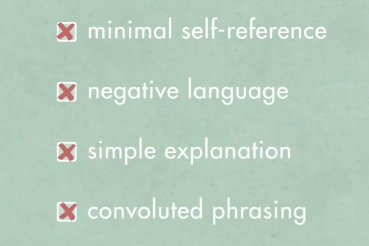#389) A Simpler Take on Lying: Narrative Dynamics
May 5th, 2015
There’s a popular and fun TED ED animated video about applying “communications theory” to lying that came out last fall which is nice, BUT … it’s still more complicated than necessary. It attempts to identify several characteristics of liars, but there’s a simpler principle underlying most of what is said, which is the fundamental rule of, “the power of storytelling rests in the specifics.” Bottom line: Dude, most of this stuff just ain’t that complicated.
LIAR, LIAR, WORDS ON FIRE
Last fall Noah Zandan, who is big on “quantified communication” posted a fun TED ED video about ways to spot liars using “communications theory.” He opens the video with a simple ABT about how lots of ways have been developed over the ages to detecting lying AND they all work to some extent BUT ultimately they can all be fooled, THEREFORE we need a different means to analyze the language of a liar. From there he points to what is called linguistic text analysis.
Which is nice, BUT … I’m going offer up an even simpler way to look at this, which is to examine the underlying narrative dynamics.
THE CLEAR TRUTH ABOUT OBFUSCATION
What he presents are four different shapes of the language used by liars. In the video he gives detailed explanations of each and offers up examples, especially from famous politicians who got caught lying (no shortage of material there). Here’s what he concludes — four language patterns common among liars.
1 MINIMAL SELF-REFERENCE – “liars reference themselves less when making deceptive statements” “often using the third person to distance and dissociate themselves from their lie.” What this means is putting the focus on someone or something else, leaving yourself more vague.
2 NEGATIVE LANGUAGE – “liars tend to be more negative” “for example they might say my stupid cell phone died, I hate that thing.” This means they add on extra, conflict-rich wording as a means of distraction.
3 SIMPLE EXPLANATION – “liars typically explain events in simple terms” “As a U.S. President once famously insisted, ‘I did not have sexual relations with that woman.’” This means in addressing the material they need to lie about, they resort to vagueness.
4 CONVOLUTED PHRASING – “liars tend to use longer and more convoluted sentence structure, inserting unnecessary words and irrelevant but factual-sounding details to pad the lie.” They achieve vagueness through narrative confusion.
The overall pattern is: DISTRACTIONS: clarity good THE LIE: clarity bad
THE NARRATIVE RE-INTERPRETATION
I don’t know exactly what “linguistic analysis” is but it sounds more convoluted itself than what is needed to grasp the basic dynamic of what’s going on. The core principle at work is basic storytelling, for which one of the most simple and universal principles is that, “the power of storytelling rests in the specifics.”
Take a look at these four patterns described and you can see at their core, the main variable at work is simply specific versus general communication. If the liar is wanting to distract, then specifics provide the power. If the liar is wanting to be vague, then leaving out specifics is the answer.
1 MINIMAL SELF-REFERENCE – liars paint a SPECIFIC picture of something else, leaving themselves more general and vague
2 NEGATIVE LANGUAGE – conflict-rich SPECIFICS distract from the truth
3 SIMPLE EXPLANATION – the liar is covered up by not being SPECIFIC (remaining general and vague)
4 CONVOLUTED PHRASING – the lie is covered up by presenting an overly SPECIFIC narrative
He also goes on to apply “linguistic analysis” to the lies of Lance Armstrong and John Edwards. But in both cases, it’s the same simple pattern. When the dude is lying, the narrative is weak through over-complication or being non-specific. When he wants to be honest he is specific. Same, same.
He ends by saying how you can use this information in your daily life. He offers up the four categorizations, but I’d make it simpler, which is more useful — just develop a sensitivity to “the power of specifics” in storytelling.
FOREVER STORYTELLING ANIMALS
As Jonathan Gotschall said with the title of his 2013 book, we are, “Storytelling Animals.” This is the core premise of my upcoming book, “Houston, We Have A Narrative,” which will come out in September but is now posted on Amazon. What the book is about is that we have been recording stories for at least 4,000 years, but recorded science only goes back a few hundred years. Which begs the question of which means of communication would you expect to be more dominant?
The idea of “linguistic analysis” sounds cool, but in the end, the simplest and most powerful of all dynamics for understanding communication is simply narrative, for which there are just a few very simple rules of thumb that explain so much. The power of specifics is perhaps the most all-encompassing of all. The deeper you absorb it, the more you see how much of what goes on in our world is driven by it.
And p.s. — beware of communications folks looking to over-complicate the world. When I finished film school at USC I did a 20 minute video called, “Talking Science” where I interviewed faculty from both the Cinema School and the Annenberg School of Communication. That’s where I first saw this pattern, clear as day. The communications folks could theorize about how to communicate. The film folks knew how to actually communicate.
